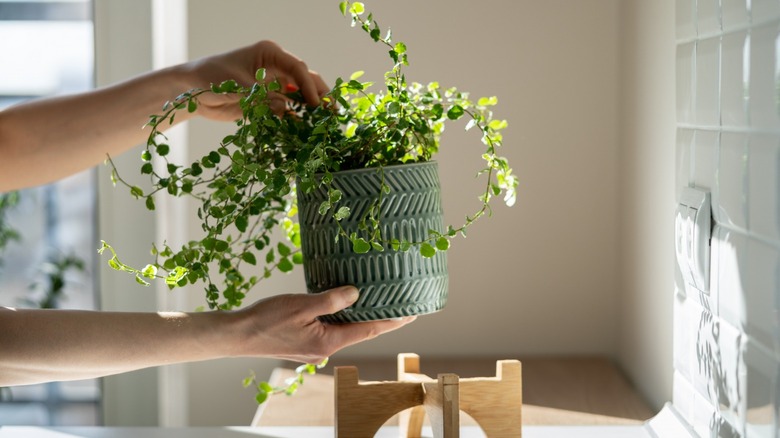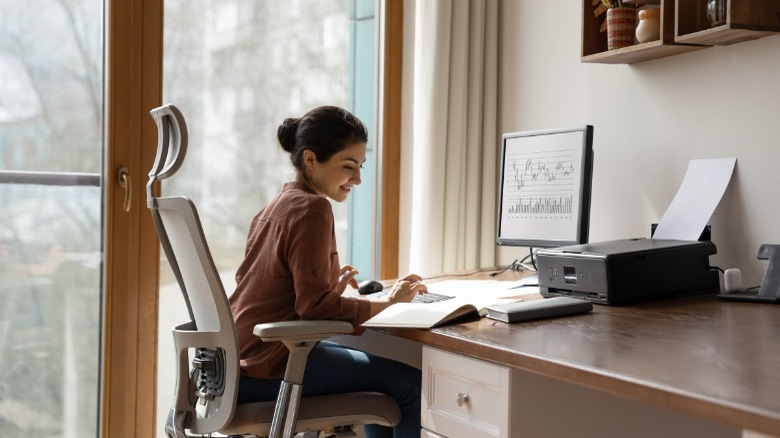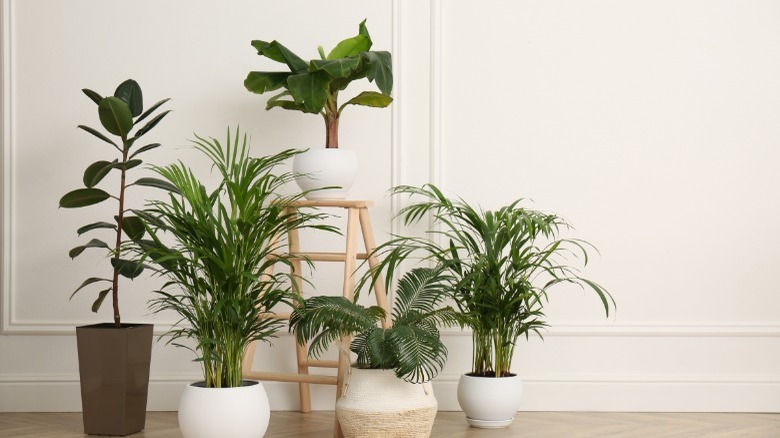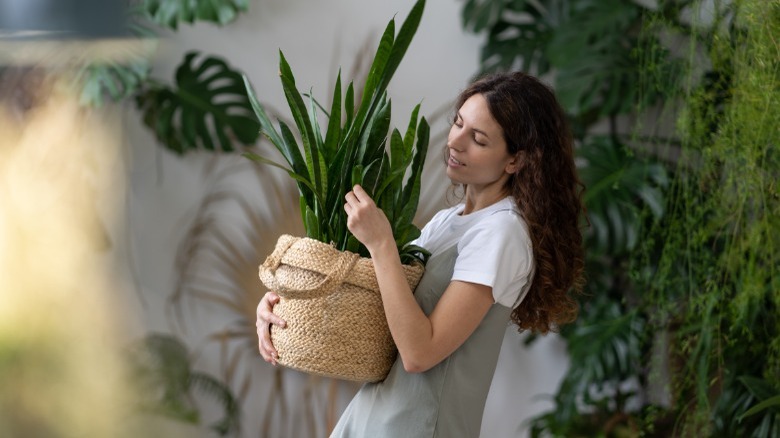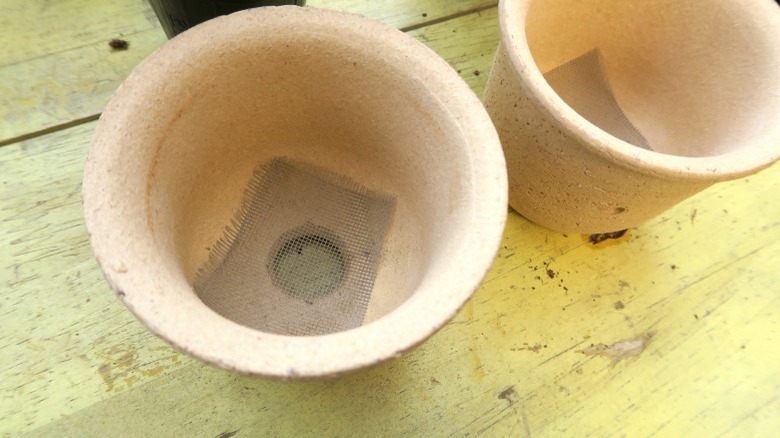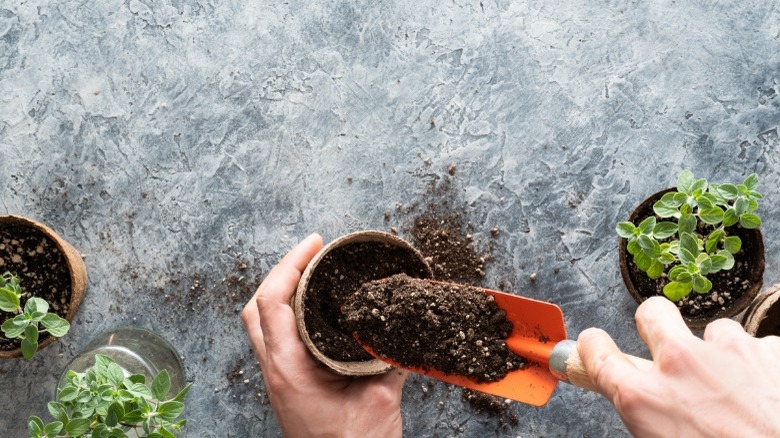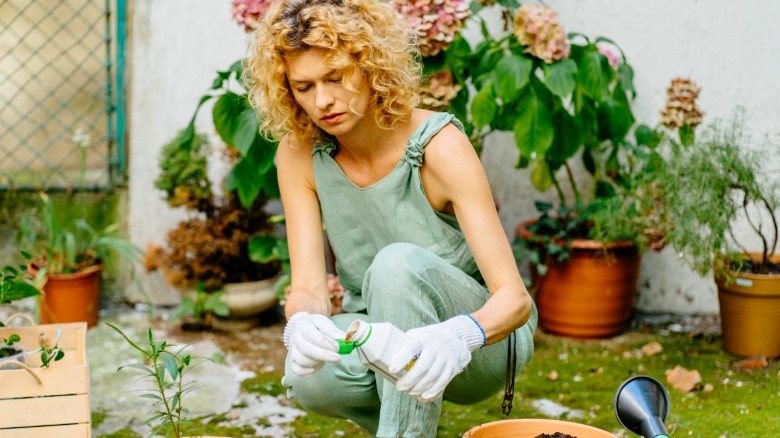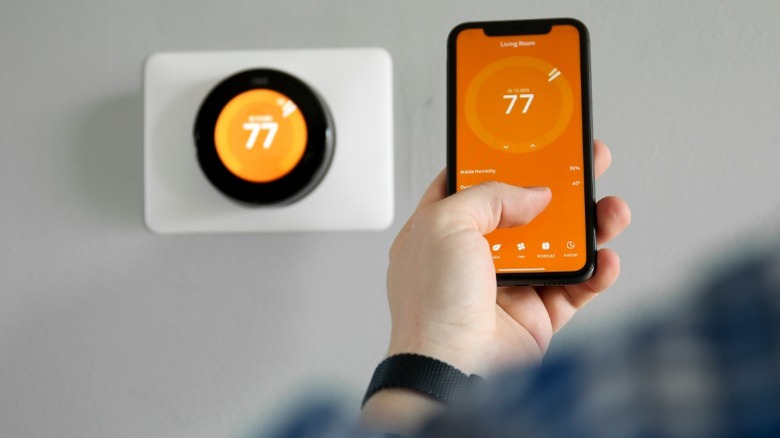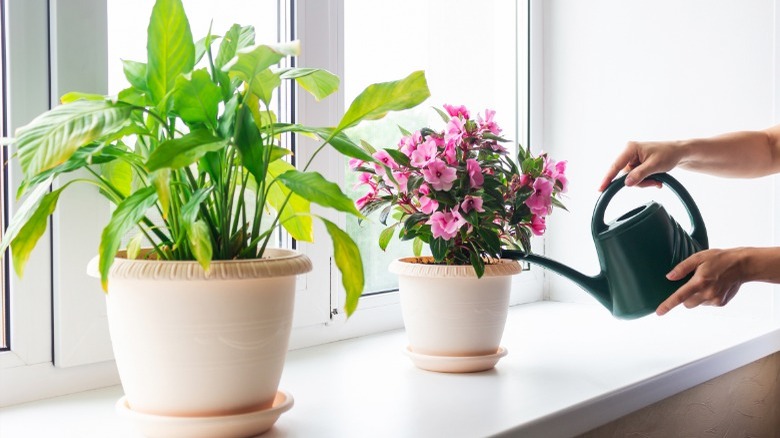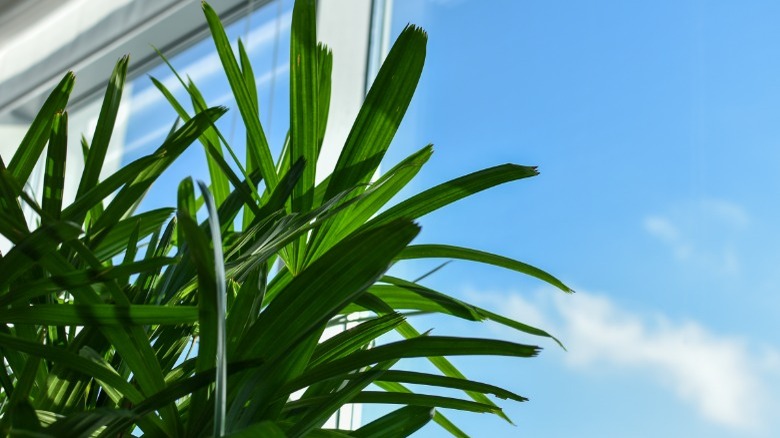How To Care For Houseplants When You Don't Have A Green Thumb
Did you know that practically no matter what kind of conditions you have in your home, you can find plants that will thrive in it? It's true, according to Gardener's Path, so don't let that deter you from adding some greenery to your home. Or, perhaps you've just been intimidated by the thought of being responsible for something alive. We get it. Not all of us feel like we have even the tiniest bit of green in our thumbs. But even if you don't know a fern from a lettuce plant, by the end of this article you'll be confident enough to grow either one indoors.
One of the main things to remember while you wait to feel some green pumping into that thumb is that, at first, everything houseplants need to thrive should be done moderately. Believe it or not, most houseplants prefer the soil a little dry, rather than too much moisture. Another tip is to be sure there's some air circulation in the space with plants. The idea is to replicate the ideal natural conditions of the plant, as closely as possible. How to care for houseplants when you don't have a green thumb is not as hard as it sounds, so let's get started!
Research the type of plant you want to grow beforehand
Assuming you're starting at ground zero, begin by researching the best houseplants for beginners, and then by specific plant (via Get Busy Gardening). Each plant will have its own individual requirements, but luckily, we have the internet! It's easy to find the information we need on anything and everything — including plants. And since every plant is different, it's something you'll want to familiarize yourself with. Although you're sure to find plants you can grow indoors, the care and maintenance requirements will vary.
For example, remember those ferns? Well, according to the Wallitsch Garden Center, there are four varieties of ferns you can easily grow indoors. Most ferns need humidity and bright, but indirect, sunlight to thrive, so kitchens and bathrooms are ideal indoor locations. Lettuce plants, on the other hand, can be grown year-round on a windowsill indoors, preferably a south facing one (via Gardener's Supply Company). There's nothing quite like growing your own salads, fresh-picked and pesticide-free! So, you see, these are both considered appropriate houseplants, but their care is very different.
Match light conditions to the plant
It's true, all plants need some light to grow lush and healthy, per the University of Minnesota. The best way to choose a plant is by picking one suited for the lighting conditions of your space. Too little sunlight can stunt the plant, preventing any new growth or blooms. Too much light can burn the leaves and bleach their color. The first thing you should do is monitor the hours of light you have in your home for each window or room, then choose a plant for those conditions.
For example, low light plants are ideal for a north-facing window or even in a corner that doesn't get much light. These plants don't need any direct light, because in nature they live underneath other foliage. Medium light plants should do well in a room near east- or west-facing windows, but not directly in line with them. For a high light indoor plant, a bright, south- or southwest-facing window is necessary (you'll want to check the soil often for these plants, because they can dry out faster).
Don't place plants too close to each other
The next tip is to not place your houseplants too close to each other, or crowded among other objects, per ScienceDaily. Believe it or not, plants feel touch, and when they sense something touching them, it could initiate a natural defense mechanism that inhibits its growth. Leave room for plants to grow without obstruction, giving them the best chance to thrive. Even too much human touch is not recommended.
Studies show that even in nature, when plants are touched by an animal or even insects — or, yep, other plants — it instigates an enormous reaction in the genes of the plant. In fact, within just half an hour, 10% of the plant's genome will be altered by one touch! What's the moral of this story? You can talk to your plants, but refrain from touching them too often. Not all plants have such an extreme reaction, but it's best to err on the side of caution if you want your plants to really do well.
Choose the right size planter
Okay, now it's time to think about containers, and first we're going to talk about size. According to Jay Scotts, though there are a million different types of indoor planters to choose from, it's actually a pretty important part of the process. The size of the pot you put your houseplant in matters, because if it's too small, the plant can't establish the root system it needs to grow. If it's too large, the soil is prone to either dry out or stay too moist — not to mention it throws off the look you may be going for.
Start with buying a plant that's already potted. You can use the size of the pot it's in as a guide, and purchase an additional one no more than an inch or two larger in diameter. You can then re-pot it into the slightly larger container of your choice when you get home. You should only need to re-pot your houseplants about once every couple of years. If you want to control the size of your plant, it will grow into the size of the planter, so you can gauge how big it will get by that. The plant will slow its growth significantly when it reaches its size capacity for the container it's in. But, with pots, size isn't the only thing that matters.
Choose a pot with adequate drainage
According to Capra Designs, the other major feature any indoor planter absolutely must have is adequate drainage. This basically means you should ensure you only buy pots that contain at least one drain hole in the bottom. When a plant is potted in a container without proper drainage, the roots will become vulnerable to root rot. Your plant's root system is like its heart, and it can't survive for long if its roots aren't healthy. Healthy roots require soil that can breathe and drain well.
Of course, this means you'll want to purchase planters that include a drain tray for excess water to drip into, or you can just buy one separately. Since these plants will be living indoors, this is a must. You can even try simple self-watering pots if you like, which have a unique system that allow you to pour water into the drip tray so that plant's roots can pull water up into the plant as needed (via Greenery Unlimited). It's called sub-irrigation, and is a great option for beginners. Either way, be sure to only buy containers with good drainage.
Choose the right kind of potting mix
The right potting mix is crucial, but the many choices can be overwhelming. As discussed by Wild Interiors, the right mix will contain plenty of added materials to help it drain easier. It's different depending on the mixture you select. It can be pearlite, sand, peat moss, or even wood fibers or chips, but most potting soil has some kind of additive to help it stay aerated, and to aid in drainage. This is also why you don't want to compact it too much when repotting.
Did you know that potting soil and potting mix are different things? Potting soil is mostly used outdoors in gardens, whereas potting mix is made for small planters and containers, such as ones that would hold houseplants. When purchasing the appropriate potting mix, be sure to choose one that promotes good aeration and drainage, and is the correct blend for the type of plant you're growing. The other important aspect of the mix you choose is making sure the pH balance stays neutral or slightly acidic. This is important so that when you add fertilizer, the plant can absorb the nutrients.
Use fertilizer
According to Savvy Gardening, it's important to keep houseplants fed with fertilizer every so often for optimum health. Lucky for all of us who don't have a green thumb, most houseplants can be fed on a similar schedule. You want to start with a water soluble fertilizer, and even though your plants are indoors, they'll feed best on a schedule that matches their natural growing season. Here are some general guidelines that you can follow safely.
Start feeding houseplants about two months before the last expected frost, typically about mid-March. Be sure you dilute the fertilizer by about half the recommended strength for the first three feedings. During the summer season, fertilize more often. Then, in the fall, start tapering off about eight weeks before the first frost, and take down the strength of the fertilizer by about half again. You can also begin to extend the time between feeding to about every three to four weeks. In the winter, you don't need to fertilize. It's as simple as that!
Take temperature into consideration
Another big factor to consider for your houseplants is temperature. According to the University of Maryland, the optimal daytime temperature for most houseplants is between 70 and 80 degrees Fahrenheit. At night, the range lower to between 60 and 68 degrees Fahrenheit. But this is not to say these temperatures must be strictly adhered to all of the time — it's just the general environment they tend to thrive in the best.
It is advised that the nighttime temperatures be reduced by 10 to 15 degrees, so your plants experience a temperature change. Remember: The goal here is to mimic the plants' natural conditions as closely as possible. Believe it or not, even plants have a circadian rhythm, per Earth Observatory. So, even though they don't sleep and wake the same way we do, they definitely have a cycle. Part of their external indicators detect temperature drops in the evening. Throwing their cycle off too much can stunt their growth, proving how important temperature is.
Water indoor plants regularly
Of course, the biggest thing to remember is to keep your plants regularly watered, but again, all plants are not the same. According to Garden Health, the idea is to keep your houseplants' potting mix moist, which means either soggy nor too dry. Typically, once or twice a week is sufficient in the spring and summer. In the fall and winter you can back off a little, but still follow the same rule of thumb (green or otherwise) regarding keeping the soil moist. You'll find that your plants don't need as much water when temperatures drop outside, even if they live inside.
You really want to be careful not to overwater your houseplants, as that will kill them just as fast as underwatering. When they have too much water, the leaves and plants will start to droop, and the roots are likely to get root rot. Never leave standing water on the surface of the soil. Water until the soil is saturated and water begins to drain out the bottom, but no more. Generally, less is more, at least until you get the hang of determining your plant's needs.
Rotate plants
Finally, remember to rotate your houseplants, per La Résidence. If you place your plants in a room near a window, you'll notice they begin to lean towards the stream of sunlight before too long. Because of this, you can see that there's only one portion of the plant getting most of the sun. In order to better replicate natural conditions, the advice is to rotate your houseplants about every couple of months or so.
But that's assuming the plants need plenty of light and are in a well-lit room. If the plants are in low to medium light, they may need to be rotated more frequently, more along the lines of once a month. Just keep an eye on them, and when they start looking a little off-kilter, give them a turn so the other side gets the light. Caring for a houseplant is really not as hard as it might seem, so take these tips into consideration and go out and grow something!
